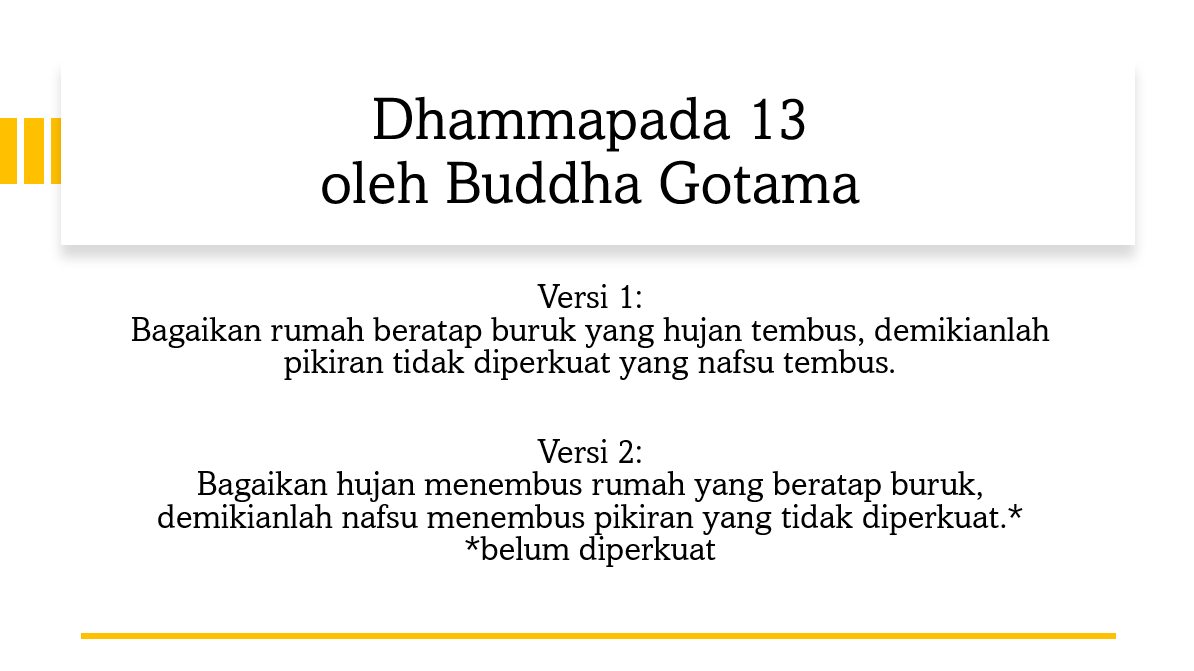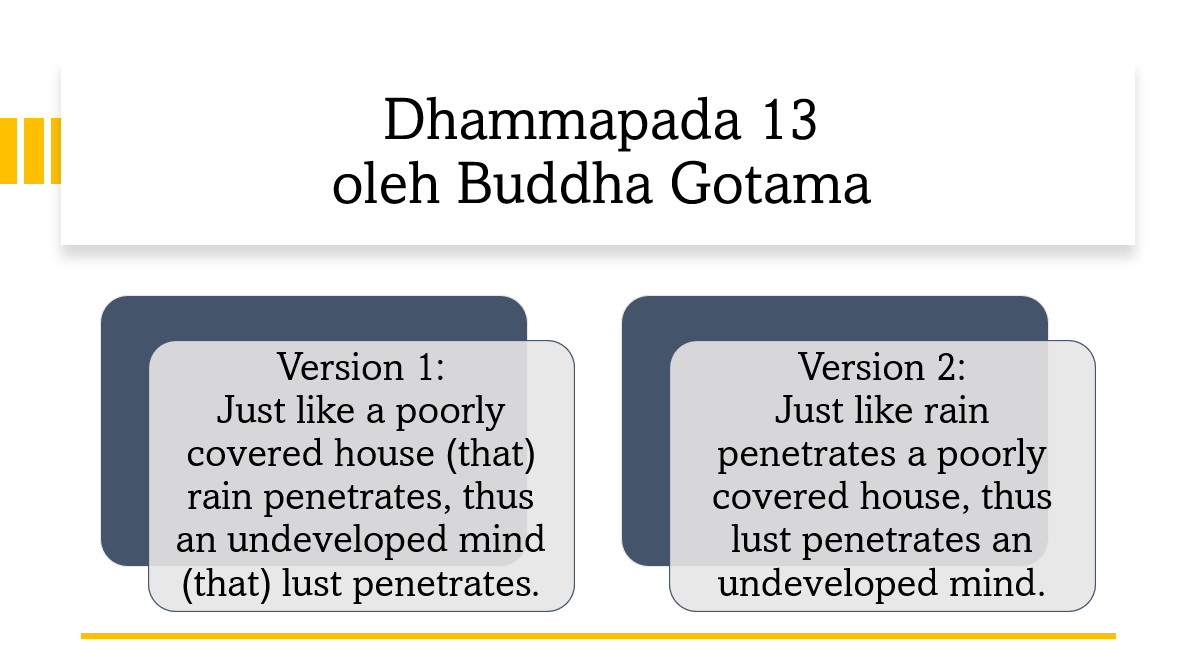Yamaka Vagga



Vocabulary |
tathā: (adv.) as, how, like;agāraṁ: (a) house; (b) derived from agāra (nt.) + -ṁ, an acc. nt. suffixducchannaṁ: (a) (sg. nt.acc) poorly thatched; (b) derived from ducchanna (adj.), derived from du (antithetic pf.) ‘bad, insufficient’ + past.part. of √chad ‘to cover’ + – ṁ, an acc. nt. suffixvuṭṭhi: (sg. fem.nom.) rainevaṁ: (adv. thus, so, in this way, likewise, either referring to what follows or what precedesabhāvitaṁ: bhāveti (3rd pers. sg. pres. indic. caus. of √bhū ‘to be’ = produces, cultivates, develops; bhāvita (adj. past.part. of bhāveti) developed; a- (neg. pf.) + bhāvita = abhāvita (adj.) = undeveloped. abhāvitaṁ (sg. nt. acc.) = un-developedcittaṁ: citta (nt.) = mind; cittaṁ (sg. acc.) = mindrāgo: rāga (masc. derived from √raj ‘ colour) = passion; rāgo (sg. nom.) = passion |
Grammar
1samativijjhati (3rd pers. sg. pres. act. indic.), derived from saṁ* (adj. pf. implying conjunction and completeness) + ati-
(pf.) ‘extremely’ + √vidh ‘to pierce’ = penetrates
* saṁ- or saṃ-, an indeclinable prefix to verbal roots:* (1) implying a conjunction, e.g., with, together;’ (2) denoting (i) ’completeness,’ (opposite vi-):
(a)Duroiselle (1915/1997:14, No. 38) writes that the niggahīta when followed by a consonant may remain unchanged.
Examples:
(x) taṁ dhammaṁ kataṁ; (ii) taṁ khaṇaṁ; (iii) taṁ patto
(b) Nasal-nasal: a nasal consonant (ń, ñ, ṇ, n, or m) followed by another nasal consonant, is assimilated to the latter: saṁ-nisīdati > sannisīdati ‘he sinks down’ (Perniola, 2001:23, No.15(a);
a.1sam-: (a) before a labial (b, bh, m, p, or ph) [(i) thus forming nasal-nasal (Perniola, idem.) (ii) niggahīta, followed by a consonant, may be transformed into the nasal of the class to which that consonant belongs (Duroiselle, idem., p. 14, No.39)]: Sambuddha (saṁ- + buddha,*), sampajāna ‘attentive, thoughtful, mindful, deliberate’ (saṁ + pajāna ‘understanding, distinguishing’)
(b) before a vowel: samativijjhati, derived from saṁ– +ativijjhati ‘(it) penetrates,’ samacchati ‘(she, she, or it, or one) sits together,’ derived from saṁ- + acchati ‘(she, he, it or one) sits
*Sambuddha: (a) saṁ- + buddha, which is derived from budh ‘to enlighten’ + -ta (a past participle suffix; if formed from a transitive verb, it makes a passive meaning ; otherwise, it forms an active meaning) = budhta > buddha ‘enlightened.’ This is as written by Perniola [idem., p. 17, No.13(a)] that when two mute consonants come together, the first is assimilated to the second since both are of the same strength:
yuj-ta > yutta ‘joined’
mad-ta > matta ‘intoxicated’
tadkāro > takkāro ‘he who does that’
sat-puriso > sappuriso ‘good man.’
The consonant t, however, preceded by one of the soft aspirate consonants gh, dh, or bh, is first shortened to d and then assimilation takes place:
labh-tum > labh-dum > laddhum ‘to bobtain’
lubh-ta > lubhda > luddha ‘greedy’
budh-ta > budh-da > buddha ‘enlightened ;’
(b) Duroiselle (ibid.,p 18, No.63) writes that when initial t follows a sonant aspirate (gh, jh, ḍh, dh, or bh), the assimilation is progressive: the final sonant aspirate loses its aspiration, the following t (surd) becomes sonant, viz. d, and, taking the aspiration which the final sonant has lost, becomes dh:
EXAMPLE:
√rudh+ta=rudh+da=rud+dha=ruddha
a.2saṁ– before (i) a surd (or sibilant) (s), labial (b, bh, m, p, or ph), or glide (or semi-vowel) (y,* or v):, e.g., saṁsara, Saṁbuddha,* saṁyojana,b saṁyutta;b

Remark: In the case of final bh, initial t having become dh, regressive assimilation takes place: √labh + ta = labh + da = lab + dha = laddha ‘(having) taken, obtained, received;’ (labhati ‘obtains, takes, receives’)
a.2.1 by assimilation, also san– before a dental (d, dh, t, th, or n), e.g., santapeti, sandahati;
a.3saṅ– or saṇ: (a) before a guttural (or velar) (k, kh, g, gh, and ṅ) or aspirate (h), e.g., (i)saṅgha ‘assembly, community, brotherhood, sisterhood, order, or a chapter of a certain Buddhist order, or a certain number of monks;’ (ii) saṅkhāra, saṅkhata, asaṅkheyya; (iii) saṇha ‘smooth, gentle, mild,’ (Andersen, 1907/2020:253); saṇheti ‘to brush down’ (Davids & Stede 1921-1925/2005, Part VII, p.131);’ (b) before retroflex, or cerebral: ḍ, ḍh, ṭ, ṭh, or ṇ: saṁ+ṭhiṭṭhati > saṇṭhiṭṭhati ‘stands;’ saṁ+ṭhānaṁ > saṇṭhānaṁ ‘position’ (called as assimilation or adaptation by Perniola, 1997:14, No. 11(b)]
a.4sañ- (i) before a palatal (c, ch, j, jh, or ñ), e.g., sañcarati [also found in Perniola, 1997:14, No.11(b)], sañchidati ‘to cut, ‘to destroy,’ sañjāti ‘birth, origin, outcome;’ sañjagghati ‘to joke,’ sañña ‘perception,’ viññū ‘intelligent, wise, learned, knowledgable;’ (ii) before a word beginning with e and the ñ, the initial e changes into ññ: taṁ+eva= taññeva, paccantaraṁ+eva= paccantaraññeva; (iii) before a word beginning with h: evaṁ hi kho= evañhi kho, taṁ+hitassa= tañhitassa (Duroiselle,1915/1997:14, No.40) [see also a.3(iii)];
a.5(i)sal- before the liquids l, ļ or ļh, e.g., sallakhetti ‘to observe,’ sallapati ‘to talk with;’ sa-before the liquid r, sometimes sā-, e.g., sāratta, sārambha (Davids & Stede 1921-1925/2005, Part IV:114, Geiger & Norman, 2005, § 74.3, & the present author’s own research);
(ii) Before initial l, the niggahīta of saṁ and puṁ is changed to l:
(i) saṁ+lakkhaṇā=sallakkhaṇā; (ii) paṭi saṁ līno=paṭisallīno; (iii) saṁ+lekko=sallekho (Duroiselle, 1915/1997:14, No.39); (iv) puṁ+ligaṁ=pulligaṁ (idem., No.39);
a.6 Duroiselle( idem., No.39) writes that the niggahīta, when followed by a consonant, may be transformed into the nasal of the class to which that consonant belongs.
EXAMPLES with (the explanatory notes in the parentheses being added by the present author):
(xli) raṇaṁ+jaho=ranañjaho (ñ belongs to the guttural (or velar) consonant class or group, consisting of g, gh, k, kh, and ń);
(xlii) taṇhaṁ+karo=taṇhańkaro;
(xliii) saṁ+ṭhito=saṇṭhito (ṇ belongs to the cerebral or retroflex) consonant class or group, consisting of ṭ, th, ḍ, ḍh, and ṇ);
(xliv) jutiṁ+dharo=jutindharo (n belongs to the dental consonant class or group, consisting of d, dh, t, th, and n);
(xlv) saṁ+mato=sammato (m belongs to the (bi-)labial consonant class or group, consisting of b, bh, p, ph, and m);
(xlvi) evaṁ+kho=evań kho [see (i)];
(xlvii) dhammaṁ+ca=dhammañca (ñ belongs to the palatal consonant class or group, consisting of c, ch, j, jh, and ñ);
(xlviii) taṁ+niccutaṁ=taññiccutaṁ;
–Iklan–

Untuk informasi lebih lanjut tentang manfaat dan pentingnya fang sheng, silakan klik: https://www.buddha-gotama.com/2023/06/28/buah-lebat-fang-sheng-pengikisan-kilesa/
bsaṁ- + yogo: the niggahīta following y is assimilated into the y, and both together may become ññ: saññogo
saṁ- + yuttaṁ: saññuttaṁ
Often, no coalescence takes place, and both letters remain unchanged:
saṁyuttaṁ, saṁyojanaṁ (Duroiselle, 1915/1997:14, No.41).
Examples taken by the present author from the other stanzas of the Dhammapada:
31: saṁyojanaṁ >saññojanaṁ
37: saṁyamessanti > saññamessanti
*(Davids & Stede 1921-1925/2005, Part IV:114, Geiger & Norman, 2005, § 74.3, & Tjan’s own research)
Davids & Stede (ibid.) writes that saṁ- (or saṃ–) is the second most frequently (16%) used prefix in Pali after vi- (19%).
Davids & Stede (ibid.) writes that saṁ- (or saṁ-) is the second most frequently (16%) used prefix in Pali after vi- (19%).
|
English 1: |
English 2: |
|
Just as the rain can penetrate |
Even as rain breaks through an ill-thatched house. So lust breaks through an ill-trained mind. |
|
Indonesia: |
Indonesia: |
|
Bagaikan (air) hujan yang merembes sebuah rumah yang beratap buruk, demikianlah nafsu indera merasuk pikiran yang tidak dikembangkan. |
Seperti air hujan yang menetes menembus atap jerami yang jarang, demikianlah nafsu keinginan menembus batin yang rapuh (tidak terlatih) |





